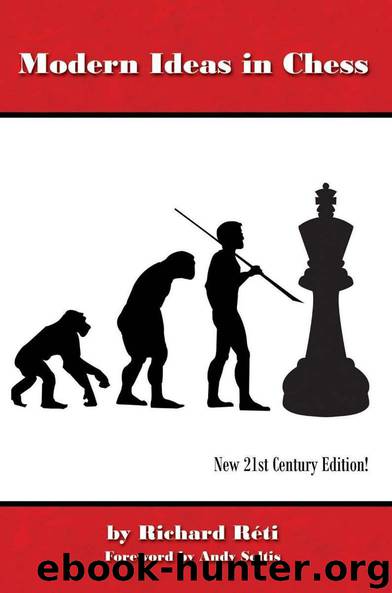Modern Ideas in Chess by Reti Richard

Author:Reti, Richard [Reti, Richard]
Language: eng
Format: epub
Tags: Chess
ISBN: 9781888690620
Publisher: SCB Distributors
Published: 2011-03-31T22:00:00+00:00
The attack on the queenside for some time interrupted is now resumed and brings about a speedy termination.
49 ... Kf8
50.b5 Resigns
If 50...a×b5 51. a×b5 Be8 52. b×c6 B×c6 53. N×c6 b×c6 54. Ke5 etc.
Chapter 4
The Perfection of Chess Technique
22. Storm and Stress
At the turn of the century chess seemed to fall into a state of stagnation. Lasker, after his great successes at the tournaments in London 1899 and in Paris in 1900, became the undisputed world champion and could with pride retire for some years from the arena.
The former world champion, Steinitz, and the youthful Charousek were dead, and Pillsbury, it was certain, would follow them a few years after. As young and first-class talent was a long time coming to the front, it was always the same masters that obtained first prizes: Tarrasch and Schlechter and in addition Maróczy, the master of defence, and the two masters of attack, Janowsky and Marshall, who possessed a wealth of ideas, but who nevertheless were not quite a match for the three masters above mentioned.
Nearly all the masters of that time were so much under the influence of the Steinitz – Tarrasch theories that their own personalities were forced completely into the background, with the result that, in the games of that period, the period itself becomes more clearly recognizable than the players.
This stagnation appeared most distinctly in the exceedingly large number of short games between first class masters and drawn by them without a fight.
The first inroad into the ranks of those privileged great masters took place at the Ostend tournament of the year 1906. The first prize properly went to Schlechter; the second fell to Maróczy. And next in order of prize winners was young Rubinstein who then took part for the first time in an international tournament.
But it was an essential feature that in that same year, and in the years that followed, quite a number of younger masters like Spielmann, Nimzowitsch, Tartakower, Duras, Vidmar, and the young Perlis (now dead), played, with ever increasing success, games full of desire for lively attack, such as had hardly ever been seen in the last preceding years.
The struggle against the predominating tendency was accentuated by the young men of storm and stress, particularly by their choice of openings. Hitherto only two openings were in vogue, The Spanish (Ruy Lopez) and the Queen’s Gambit. Perlis, Spielmann and Tartakower at that time had a preference for attacking games such as the Vienna game or the King’s Gambit.
In the defense they avoided at all cost the enclosed positions which at that time had found favor, and which to the great masters of investment, like Tarrasch in particular, had afforded the opportunity for big triumphs.
Spielmann for example favored the gambit defence to the Ruy Lopez and Nimzowitsch the Hanham defence. Especially destructive of old barriers, for the future, became the defense favored by Nimzowitsch and Tartakower, namely, the Chigorin Defense (1. d4 Nf6) which as is known, is also a favorite defense, with modern players in the Queen’s Pawn opening.
Download
This site does not store any files on its server. We only index and link to content provided by other sites. Please contact the content providers to delete copyright contents if any and email us, we'll remove relevant links or contents immediately.
The Infinite Retina by Robert Scoble Irena Cronin(6049)
Harry Potter and the Cursed Child: The Journey by Harry Potter Theatrical Productions(4425)
The Sports Rules Book by Human Kinetics(4268)
Molly's Game: From Hollywood's Elite to Wall Street's Billionaire Boys Club, My High-Stakes Adventure in the World of Underground Poker by Molly Bloom(3471)
A Knight of the Seven Kingdoms by George R R Martin(3173)
Quidditch Through the Ages by J.K. Rowling(3051)
How To by Randall Munroe(3014)
Quidditch Through the Ages by J K Rowling & Kennilworthy Whisp(2921)
Flowers For Algernon by Daniel Keyes(2905)
Quidditch Through the Ages by Kennilworthy Whisp by J.K. Rowling(2807)
Stacked Decks by The Rotenberg Collection(2794)
Quidditch through the Ages by J. K. Rowling(2755)
Quidditch Through The Ages by J. K. Rowling(2720)
776 Stupidest Things Ever Said by Ross Petras(2675)
Ready Player One: A Novel by Ernest Cline(2634)
What If?: Serious Scientific Answers to Absurd Hypothetical Questions by Randall Munroe(2626)
Beautiful Oblivion by Jamie McGuire(2556)
The Book of Questions: Revised and Updated by Gregory Stock Ph.d(2501)
Champions of Illusion by Susana Martinez-Conde & Stephen Macknik(2402)
